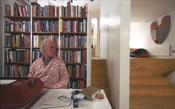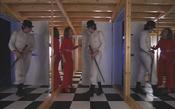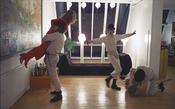The Aesthetics and Politics of Audiovisual Images
What does it mean to view the world through different (cinematographic) eyes in film? – Films in their duration unfold a specific sensorial nature – a specific way of seeing, of hearing, of feeling – which differs from the everyday mode of perception. With this concrete audiovisual sensuality of cinematic images comes the hope that film could make tangible the social, historical, and media-related circumstances of the world’s everyday potential of experience itself. Only through this possibility to experience the socially divided orders of perception, the individual can begin confronting them and raise an objection (as defined by Rancière) against the order of a specific perceptual world. The aesthetics and politics of film are, thus, closely intertwined.
The Cinema and the Politics of the Aesthetic
Realismus: das Kino und die Politik des Ästhetischen investigates this connection of aesthetics and politics, finds its origins in the aesthetic utopias of the 1920s, and analyzes their relevance in Western cinema after 1945 based on specific films (from Visconti through Fassbinder, all the way to Kubrick, Friedkin, and Almodóvar).
From the encounter of film and avant-garde – see for example Sergej Eisenstein’s works or the aesthetic programme of the New Objectivity of Weimar Cinema – the idea grew that the new medium could make tangible the (real or yet to be created) conditions for a social living together as a physical being-in-the-world.
After 1945, the discrediting of the idea of the mass medium through the experiences of the Second World War was answered with a film-theoretical turn by Siegfried Kracauer and André Bazin: Contrary to a mobilization of a collective existence in the avant-garde cinema , film is now regarded as a possibility of giving the individually addressed viewer an outlook onto the social reality which as a scope of action has gone missing. The avant-garde’s aesthetic utopia is transformed and can be understood as a new form of realism. The visual spaces of cinema open up the outer reality as a field of possible experience of social reality. In this sense, the term ‘realism‘ does not refer to the degree of correspondence to the everyday experience, but rather to the possibility of experience of social orders within the individual feeling. With relation to Jacques Rancière, thus the political dimension of the aesthetics of audiovisual images unfolds: films as a perception of social orders not within social orders can be an objection to the ‘distribution of the sensible.‘
Further information about the book: Realismus: das Kino und die Politik des Ästhetischen.
The Sensibility of Another Time
An analysis of Luchino Visconti's LA CADUTA DEGLI DEI in Realismus: das Kino und die Politik des Ästhetischen shows how history can be staged as an almost intangibly aesthetic transformation of space – film as an experience of the sensibility of a past time which is understood as a lost possibility of history.
Visconti’s films unfold a world from which the spectator is radically excluded. And yet, he still participates in this sensibility through an aesthetic experience of perception, his experience of the beauty of the film’s things and people. In this aesthetic experience, the spectator enters a close relationship with the protagonists of Visconti’s films.
A detailed analysis of Luchino Visconti’s historical films can be found as a multimedia online-publication: Visconti: die Sinnlichkeit einer anderen Zeit.
Social Analysis as an Aesthetic Viewer Experience
When rereading the early works of Rainer Werner Fassbinder from a standpoint of the experienceability of social orders – as in The Distribution of Emotions: Fassbinder and the Politics of Aesthetics –, the staging of the group makes especially clear how the characters’ personal relationships mirror social power structures and vice-versa. The intellectual society analysis becomes an aesthetic viewer experience.
Detailed analyses regarding Rainer Werner Fassbinder's films and their specific acting style, which correlates Brecht’s social gesture with the melodramatic acting of the Hollywood film, can be found as a multimedia online-publication via: Nach '68 - Politik der Form (R. W. Fassbinder).
Further reading:
The Distribution of Emotions: Fassbinder and the Politics of Aesthetics. In: The Germanic Review: Literature, Culture, Theory, 86:3, 2011. p. 201-220
(see also: "Ein Denken, das unmittelbar Gefühl, und ein Fühlen, das..." Utopie Film: R.W. Fassbinder und die Frage nach einer "Politik der Form". In: Das Streit-Bild. Film, Geschichte und Politik bei Jacques Rancière / Drehli Robnik, Thomas Hübel, Siegfried Mattl (eds.). First edition. Wien / Berlin: Turia + Kant, 2010. p.161-176.)
"[…]the beginning of WARNUNG VOR EINER HEILIGEN NUTTE, or more precisely, the first fifteen minutes of the film, is an appropriate place to trace the directorial operations that position the image of the group as a form of media perception.[…]
We see Fassbinder in the role of the production director Sascha and Scheydt as the producer Manfred. Sascha screams into the telephone while Manfred watches him. Once again, the sight lines meet at a right angle. In what follows, these geometrical figures are repeated in ever new variations: two intertwining gazes form a line that is cut at a right angle by a gaze from outside; then this arrangement is repeated within the shot. […]
The succession of the sight lines, related to one another in strict angles, articulates a tension that soon turns out to be a disharmonious network. One person gazes intently at another, who in turn remains unaware of being looked at. This is followed by characters whose walking transforms this tension into axes of movement, which are again arranged following the same principle: sometimes they cut one another at dynamic right angles, and sometimes they meet in direct opposition like the intertwined gazes; while sometimes they continue each other as in a relay race. There is no master shot, no preconceived space. Instead, a movement image is gradually assembled: loosely attached frames, individual characters, couples in conversation—all connect with each other by the arrangement of the lines of sight and the lines of movement created by people walking.
Finally, the movement of the camera contributes the last element. It initially follows the characters walking, only to develop a movement of its own soon thereafter, which gives it enormous presence. Even before a space of action becomes perceivable to the spectator, the diagram of a network of relationships has been set up."
(Excerpt from The Distribution of Emotions: Fassbinder and the Politics of Emotions)
A New Sensitivity
In issue #9 of Film-Konzepte on Pedro Almodóvar, various authors look into the political dimensions of his work (in the sense of Rancière): Which positions of subjectivity and relevance to the world can be thought through Almodóvar’s films? What thus far unheard-of sensitivity is articulated through them?
Various films by Pedro Alodóvar – as a representative of a new sensitivity of the Western (auteur) cinema – show how the director is able to grasp regional historical experiences and cultural traditions, while also being able to take them beyond their specific cultural context. The essay Der Auszug aus Bernada Albas Haus shows how Almodóvar dissolves a singular internal perspective, a first-person-perspective, and instead constructs a (female) subjectivity through a permanent change of perspective, a kind of cinematographic Cubism.
This detailed study on Pedro Almodóvar is available as a multimedia online-publication: Pedro Almodóvar: Eine neue Empfindsamkeit.






